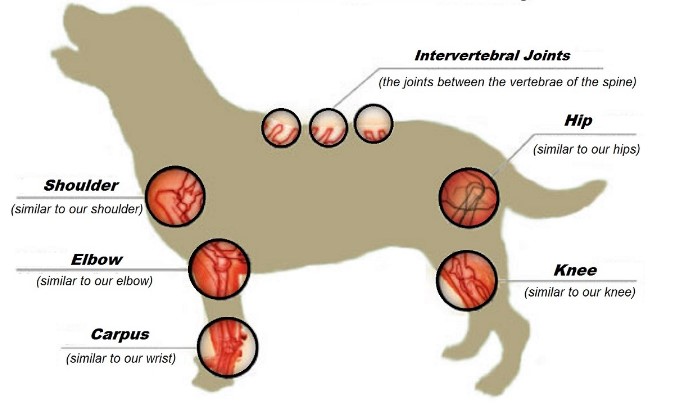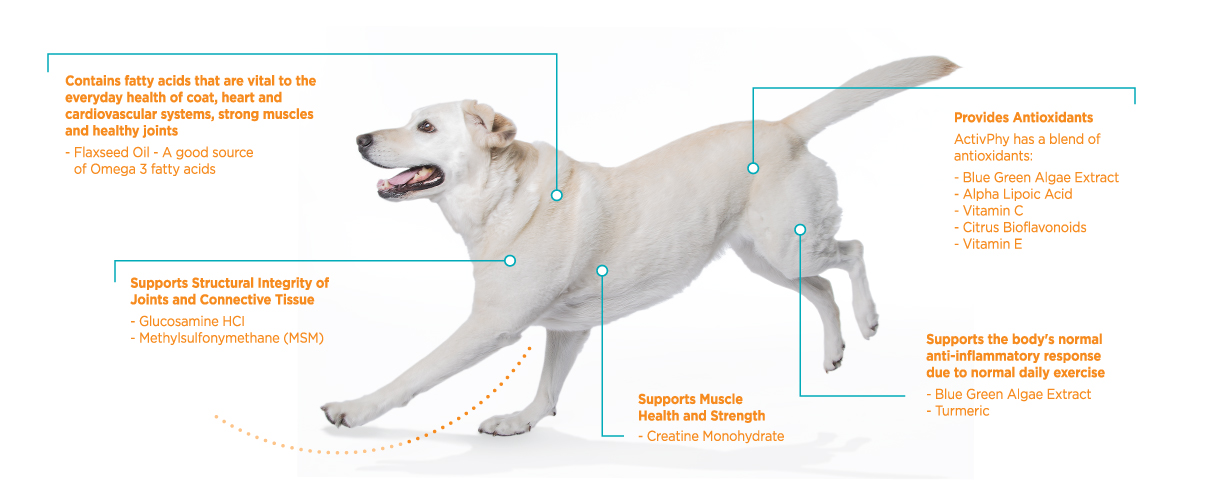Whether your dog is old and stiff, or young and still developing, or he is merely just a couch potato, as a pet owner, you are probably concerned about their joint health. You find your self online, continuously searching for information about arthritis, joint mobility, or even asking other pet owners about it.
Well we’re glad you stopped by, this article was written to address your concerns.
Common joint problems in dogs

You’ve probably come across questions concerning things like the hyperimmune milk factor, or Boswellia serrata, and wondered how to shed light on it all. Plus you may be puzzled about:
- how much to glucosamine to give your dog?
- or how often you should give your dog glucosamine?
- or which brand of glucosamine supplement you should use?
All of this, in addition to which information may be accurate and which may be clever marketing, can be a big puzzle. Fortunately, Matt Brunke, CCRP, DVM, CVA CVPP. addressed all these questios from an experts point of view, which we will get to below.
But first, let us first understand the common joint problems which dogs can develop.
Osteochondrosis

This is sometimes known as ‘growing pains’ or the ‘too rapid growth disease.’ It mostly affects the large sized, medium, or giant breeds of dogs, and the underlying cause for this disease is still unknown.
Some research shows that it may be hereditary, or, it may be triggered by the lifestyle or dietary choices of your dog.
For this reason, it is not always easy to avoid it, but keeping a close eye on what you feed your pup may go a long way in easing up on the problem of osteochondrosis.
Osteoarthritis (degenerative joint disease)
This one can be triggered in different ways. It sometimes starts in young dogs due to their developmental abnormalities, e.g. osteochondrosis, or they can be inherited joint deformities from their parents.
At other times, however, the natural wear and tear of a dog’s bones can cause their joints to start breaking down. Other issues could be lameness, muscle wastage, bone thickening, etc.
Dysplasia
This actually means a “malformed socket” which can either affect the shoulders, the hips, or the dog’s elbows. It is a hereditary condition that can be found more often in larger dogs than in the smaller breeds.
Typically the only treatment for this is a surgical procedure. In the long run, however, if your dog suffers from dysplasia, they will most likely be unable to walk.
Arthritis
There are many different types of arthritis that can arise – from cancerous causes, infections, or autoimmune problems. Fluid buildup, stiffness, and joint swelling are common arthritis symptoms. It is a hereditary problem that is often found in pure breeds and hybrid dogs alike.
The various supplements for dog joints

An experts take on supplements that promote dog joint health
According to Dr. Brunke, a veterinary specialist in rehabilitation and pain management based out of Washington D.C., the supplements that have been getting the most buzz nowadays are the following.
Glucosamine hydrochloride
This is an amino acid, but it is not involved in the glucose pathway. It is a building block from the cartilage matrix whose primary purpose is to stimulate the growth of the cartilage cells. It is easily available, cheap, and, according to Dr. Brunke, can be administered to diabetic dogs.
Please bear in mind that the discussion here is about glucosamine hydrochloride and not glucosamine sulfate. Although the sulfate is absorbed much better, there have been some studies stating that it can be seen in the synovial tissue after ingesting it orally. Now, a joint supplement is rendered useless if it does not get to where it is supposed to go.
Dosage
The doc states that a dosage of 2 per day for 4-6 weeks is enough to reach the therapeutic levels.
Does it work?
A random research of 35 positive-controlled, double-minded dogs with confirmed osteoarthritis of the elbow or the hip was done to test their response to the orally administered glucosamine tablets. The results show that in the beginning, the management of pain was slow, but by the 70th day, there was a marked improvement.
Chondroitin sulfate
This is a supplement that works by inhibiting the cartilage-destroying enzymes. It is, however, difficult to extract and source, which makes it very expensive. The chondroitin molecule is large and it has variable absorption rates.
According to Dr. Brunke, some companies produce smaller tablets that are absorbed better in the gastrointestinal tract.
Dosage
It requires a dosage similar to that of the glucosamine supplement, and if the two are given together, they have been known to lessen inflammation especially when given before an injury.
Avocado Soybean Unsaponifiables (ASUs)
ASUS may protect the dog’s cartilage matrix from damage through the process of inhibiting the critical mediators of its structural changes. This takes place in the osteoarthritis, and it stimulates the healing of the osteochondral defects found in the canine knee.
This possibly takes place by transforming the growth factor found in the tissue. i.e. (TGF)-beta.
Dosage
The dosage used in the study was one capsule every three days, but, Dr. Brunke recommends one pill a day depending on the weight of the canine.
Omega-3 fatty acids
The Omega-3’s have been reputed to:
- boost the immune system
- support the heart and joints
- and improve the kidneys.
Dr. Brunke says that the omega-3 found in Eicosatetraenoic acid (EPA) and Docosahexaenoic acid (DHA) from the Coldwater fish is actually the best. The farm-raised fish have a low level of omega-3 and a high level of Omega-6.
Dosage
The dosage used in each condition varies, for example, for kidney ailments you’ll need to administer a fifth of the dosage used for the joints.
Eggshell membrane
This contains high concentrations of:
- chondroitin glucosamine
- hyaluronic acid
- and collagen.
According to Dr. Brunke, the absorption of these nutrients are unknown.
Green-lipped mussels
The mechanism employed by the green-lipped mussels is not yet known, but, according to Dr. Brunke, a study that was conducted in 2013 showed that dogs which had been fed a diet rich in the green-lipped mussels were found to have an increased concentration of the Omega-3 plasma.
Boswellia serrata
The Boswellia serrata extract has been known to have an NSAID-like effect. According to a 2004 study, there was a significant reduction in the severity of osteoarthritis in dogs.
Dosage
The standard dosage, according to Dr. Brunke should be 70mg/kg.
Curcumin
One of the studies revealed that Curcumin could actually inhibit the macrophage proliferation which is related to a down-regulation of the fibrinolysis activation and TNF-alpha. This suggests that the Curcumin does offer anti-inflammatory support for osteoarthritis in canines.
The standard extracts are however not well absorbed by dogs, which makes it a less-effective supplement. Also, turmeric, which is found in curcumin is not safe for dogs.
Elk or deer antler
A research that was done out in 2004 showed an improvement in the dogs that were diagnosed with osteoarthritis when the supplement made of high-quality elk velvet antler powder was administered. The mechanism of its action is unknown, however, and the dosage is also not well established.
Hyaluronic Acid
Hyaluronic acid (HA) is a naturally occurring component found in the body. It helps to support the following:
- eyes
- connective tissues
- skin
- joint fluids
- and joints.
When administered as an injectable supplement, it may deliver positive results for joint related issues. However, it is still under research and has not been sufficiently studied as yet.
Hyper-immune milk factor
This duralactin will reduce the inflammation by blocking any neutrophils from entering into the endothelial wall. The Hyper-immune milk factor supplement has been significantly studied in people, but its effectiveness in dogs is yet to be determined.
Additional tips from Dr. Brunke
Now that you have been able to understand supplements better, here are some helpful tips:
- Start the administration of chondroprotective agents as early as possible, especially in the large-breed dogs, or in any dogs that have a genetic predisposition to You can give joint supplements to puppies as young as eight weeks old.
- The omega-3 found in most dog diets is not high enough to treat specific joint related problems, so, an arthritic dog receives a diet rich in omega-3 will still need the administration of omega-3 supplements in order to attain the required therapeutic levels.

- Chondroitin Sulfate and Glucosamine Hydrochloride have been known to work. However, the onset of their success is slow and requires patience. You may need to higher doses of NSAID for approximately 2-3 months, in the beginning, to relieve your dog’s pain NSAID, then lower the dosage to the lowest levels once the supplements become effective.
- Joint supplements are actually a waste of your money if your dog is in the advanced stages of bone-on-bone osteoarthritis. In fact, DO NOT bother. But, if just one of his bones is affected, then you can give the supplements to help protect the other joints.
- Many dog treats contain Chondroitin and Glucosamine, but it is always advisable to check the ingredients list to be sure, plus, most may require you to feed your dog obscene amounts of it to get the therapeutic levels needed to treat any joint related problems.
Muscle strengthening supplements
If your dog needs to build some muscles, however, then, some muscle strengthening supplements can be administered, which include the following:
- Creatine: Commonly used by humans for building muscles and recovery from muscle related injuries. According to Dr. Brunke, if you put the creatine in your milkshakes, and you do not do any weightlifting exercises, you will only succeed in turning possible muscle formation into fat. According to him, it is good for humans but, we do not want our dogs to look like Arnold Schwarzenegger.
- Whey protein: Found in milk and has a high protein content that has been known to help humans in developing strength in their muscles, but the exact requirement in dogs is unknown.
- Others supplements you might want to consider include
- Chromium
- Dimethylglycine
- Lecithin.
Final thoughts on joint supplements for dogs

Now, finding the best supplement for your dogs joints, as we have seen, is not very easy! It may require intense research over a long period of time, plus some trial and errors in order to arrive at what will work for your precious puppy.
Take this time seriously, and also consult with more than one vet in order to acquire a second and third opinion. When you visit your vet with a suggested supplement, be sure to ask the following:
- The right time of the day to administer the supplement.
- The recommended dosage per day for your dog.
- (may depend on weight, age, and severity of the symptom).
- Whether the supplements should be given with food or in-between meals.
- What to do if your dog has trouble taking the supplements.
- (Are there other ways of administering it?)
- What are the possible side effects of the supplement?
- What to do in case of an overdose?
All in all, be sure to follow the doctor’s advice carefully and it’s never wrong to ask a question! Asking may save your dog’s life and prolong their life as well. Take your dog to the vet for regular check-ups when they are young, so these joint related problems can be detected early.
